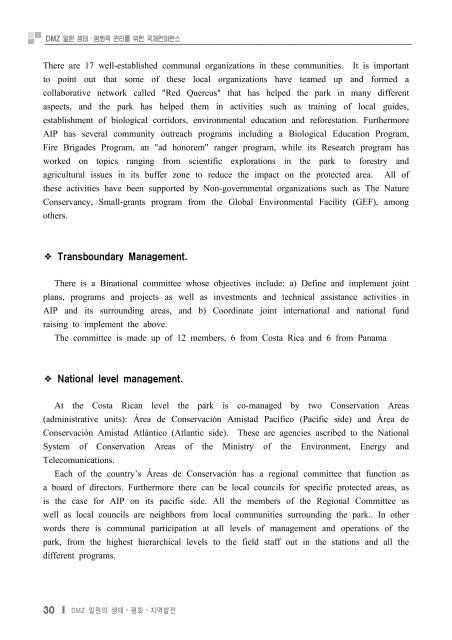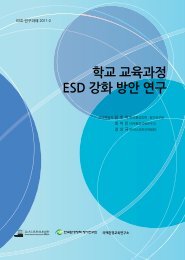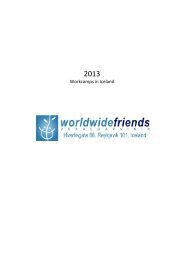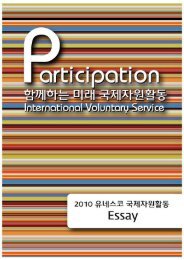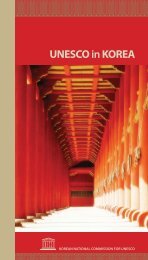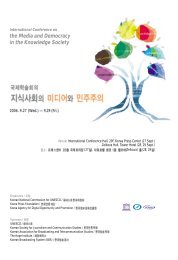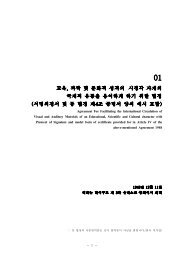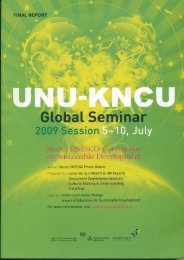DMZ ì¼ì ìí ííì ê´ë¦¬ë¥¼ ìí êµì 컨í¼ë°ì¤ - ì ë¤ì¤ì½íêµììí
DMZ ì¼ì ìí ííì ê´ë¦¬ë¥¼ ìí êµì 컨í¼ë°ì¤ - ì ë¤ì¤ì½íêµììí
DMZ ì¼ì ìí ííì ê´ë¦¬ë¥¼ ìí êµì 컨í¼ë°ì¤ - ì ë¤ì¤ì½íêµììí
Create successful ePaper yourself
Turn your PDF publications into a flip-book with our unique Google optimized e-Paper software.
<strong>DMZ</strong> 일원 생태ㆍ평화적 관리를 위한 국제컨퍼런스<br />
There are 17 well-established communal organizations in these communities. It is important<br />
to point out that some of these local organizations have teamed up and formed a<br />
collaborative network called "Red Quercus" that has helped the park in many different<br />
aspects, and the park has helped them in activities such as training of local guides,<br />
establishment of biological corridors, environmental education and reforestation. Furthermore<br />
AIP has several community outreach programs including a Biological Education Program,<br />
Fire Brigades Program, an "ad honorem" ranger program, while its Research program has<br />
worked on topics ranging from scientific explorations in the park to forestry and<br />
agricultural issues in its buffer zone to reduce the impact on the protected area. All of<br />
these activities have been supported by Non-governmental organizations such as The Nature<br />
Conservancy, Small-grants program from the Global Environmental Facility (GEF), among<br />
others.<br />
❖ Transboundary Management.<br />
There is a Binational committee whose objectives include: a) Define and implement joint<br />
plans, programs and projects as well as investments and technical assistance activities in<br />
AIP and its surrounding areas, and b) Coordinate joint international and national fund<br />
raising to implement the above.<br />
Thecommitteeismadeupof12members,6fromCostaRicaand6fromPanama<br />
❖ National level management.<br />
At the Costa Rican level the park is co-managed by two Conservation Areas<br />
(administrative units): Área de Conservación Amistad Pacífico (Pacific side) and Área de<br />
Conservación Amistad Atlántico (Atlantic side). These are agencies ascribed to the National<br />
System of Conservation Areas of the Ministry of the Environment, Energy and<br />
Telecomunications.<br />
Each of the country’s Áreas de Conservación has a regional committee that function as<br />
a board of directors. Furthermore there can be local councils for specific protected areas, as<br />
is the case for AIP on its pacific side. All the members of the Regional Committee as<br />
well as local councils are neighbors from local communities surrounding the park.. In other<br />
words there is communal participation at all levels of management and operations of the<br />
park, from the highest hierarchical levels to the field staff out in the stations and all the<br />
different programs.<br />
30 ❙ <strong>DMZ</strong> 일원의 생태⋅평화⋅지역발전


